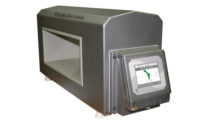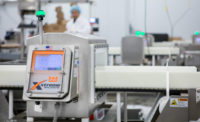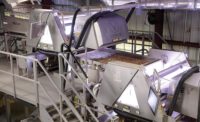Warehouse & Distribution
Keeping an eye on inspection/detection
























Inspection/detection equipment is evolving to meet the needs of bakeries and snack manufacturers seeking to improve their productivity at a time when packaging operations are becoming more complex. There is an increased need for machine versatility and flexibility to handle multiple package sizes and conform to various safety regulations. Recent advances in metal detection and x-ray technology are available to meet those challenges.
Major bakery and snack trends include a proliferation of varieties and flavors within brands, the increasing use of flexible packaging and multiple types of packaging to suit the needs of various retailers, such as convenience and warehouse stores. This increases the frequency of changeovers and places pressure on packaging operations and inspection requirements.
“More bakery and snack food companies are installing inspection/detection equipment on their packaging lines at multiple levels,” notes Kevin Weiss, product line manager at Delkor Systems Inc., St. Paul, Minn. “With the number of SKUs increasing, the growing amount of varieties within brands and multiple packaging sizes and types, bakeries and snack plants rely on inspection systems to control quality and reduce the risk of errors on the production line.”
Experts agree, there is a greater need for versatile equipment able to inspect different products in different sizes while requiring minimal changeovers. The goal is to decrease the chance of a defective product or mislabeled package reaching the consumer.
“Ten years ago, most inspection equipment was [in place] for secondary packaging [functions],” says Jeff Huerta, sales manager, packaging, for SICK Inc., Minneapolis. “Inspection is now performed during food processing, before the product goes into its primary packaging. Vision technology is being used for food inspection to ensure the quality of the product and its visual appearances.”
Bob Ries, lead product manager of metal detection and x-ray inspection at Thermo Fisher Scientific Inc., Minneapolis, sees an increase in the use of x-ray equipment for bakery and snack food applications that have metalized film in their packaging structure. “We also see an increase of baked goods that use foil trays and such trays for warm, moist breads with a high degree of variable product effect,” he notes. “In general, the sensitivity of both metal detectors and x-ray equipment is increasing, and systems have become more fail-safe to comply with global standards.”
Safety regulations
Food-safety regulations are helping to drive the evolution of inspection/detection equipment. Both the Food Safety Modernization Act (FSMA) and the new Global Food Safety Initiative standards (GFSI) require functions that support due diligence in packaging and processing. They also require more automated record keeping. “Farm to Fork” is another initiative for the food industry set by Congress through FSMA. This is a scientific approach aimed at improving food safety systems throughout the product manufacturing cycle.
While food safety is one force prompting the evolution of inspection/detection, it’s not the only factor. “Customers want to verify that products meet specifications,” adds Huerta. “For example, dimensions, color and product presentation all play a part in most of the inspections we make with customers related to food products, even before the products go into the package.”
Allergen management is another function that’s prompting bakeries and snack plants to insert machine vision components into their production lines, according to John Lewis, market development manager for Cognex, Natick, Mass. The goal is to eliminate the high cost of recalls, potential liability and loss of brand image.
What’s new?
Among a host of recent equipment introductions is Delkor’s Confirm vision detection system. Confirm can be installed over existing conveyors, according to Weiss. Typically mounted inline after the filling of containers, it performs several inspection functions and rejects packages that don’t meet specifications before they’re loaded into secondary packaging such as cartons, cases, trays, bags or shrink bundles.
Advanced Detection Systems, Milwaukee, says recent technological advances include auto-balance, which maintains consistent detection levels and eliminates the need for re-calibration. “We’ve also improved Acculearn to simplify the process of accommodating product effect and the Z-Tech power supply design to eliminate false detections caused by line spikes, radiated noise and vibration,” David C. Smith, sales manager, points out. “These core technologies are offered in all ProScan ST, XT and Max II metal detectors.”
Mettler Toledo CI-Vision, Columbus, Ohio, recently introduced the V6300, a modular machine vision system that conforms to existing production lines and helps food producers maintain high quality without slowing down production or reconfiguring existing lines.
“V6300 inspects packaged products to ensure packaging integrity and proper marking and coding,” explains Stephen Dryer, product manager. “It conforms to virtually any line type and can be upgraded as a manufacturer’s inspection needs grow.”
Mettler Toledo also has added automatic height adjustment to several of its existing systems, including the Mosaic and CLS inspection systems. “Bakery and snack food producers benefit from greater automation and simplified product changeover, and this adjustment feature repositions cameras and lights automatically with minimal input from operators, reducing downtime between batch runs,” Dryer notes.
Material Process Equipment, Highland, Mich., recently unveiled the Pro-Tector, which combines the simplicity of a magnetic separator with the reliability of a metal detector. The system assures quick removal of metals from a product stream, while its size accommodates the tight spaces commonly found in bakeries and snack production facilities. Designed for use in gravity-feed pipes to check for metal contaminants in continuous-flowing granules or powders such as sugar, flour, cornmeal or spices, the system’s drawer magnet reportedly provides maximum magnetic separation of contaminants.
Thermo Fisher Scientific has introduced NextGuard, an easy-to-use x-ray detection platform that helps provide more thorough inspection for product contamination. “Based on customer feedback, we’ve found that the total cost of ownership for x-ray systems traditionally has been too high for many companies to justify this technology,” says Ries. “Based on our testing, the NextGuard offers up to 50% better detection sensitivity than its previous x-ray system, the EZx.”
NextGuard’s performance-oriented features have been driven by a changing industry landscape. “X-ray detection addresses a number of customer concerns, including evolving HACCP [hazard analysis and critical control points] standards and requirements from some retailers for x-ray inspected product,” Ries adds.
Heat and Control Inc., Hayward, Calif., offers the CEIA THS/MS21 metal detector, which maintains high sensitivity to metals and eliminates false rejects caused by product effect due to variables such as moisture content and temperature. Thus, it can be used for products with different characteristics, while providing metal detection, according to Todd Grube, manager of inspection systems.
The company recently introduced THS Production Plus, which simplifies metal detector event recording and reporting. “It provides user authentication and manages electronic signatures and records for CEIA metal detectors,” Grube says. “The system promotes data integrity and allows operator auditing, database management and backup of all metal detector events. Report data can be exported in HTML and CSV formats.”
Cognex recently unveiled the DS1000 Series 3-D displacement sensor, which provides three-dimensional inspection of products. “Unlike traditional 2-D machine vision, the DS1000 laser profiler provides a topographical representation of the product from which length, width, height, tilt or volume relative to any surface can be measured,” says Lewis. “It also simplifies challenging optical character recognition (OCR) or presence/absence applications by creating contrast from height changes, independent of color.”
What’s in demand?
Bakers and snack producers are asking for more inspection/detection features than ever, experts agree. For example, they want more capabilities to assist in food-safety policy compliance, such as data logging, sanitary design and image-saving capabilities. They’re also favoring foreign object detectors that are easier to operate and methods to provide audit and recordkeeping data.
Inline dimensioning to verify the quality of the product in real-time is also being requested by food producers, according to Huerta. “SICK has developed a product specific to the food industry called Product Dimensioning & Trending, which allows customers to see inline trending of their product to verify that their lines are running at optimal capabilities.”
Bakers and snack producers also are asking for smart camera vision systems that work reliably in Food and Drug Administration (FDA)-regulated washdown environments. “To address that need, Cognex offers the stainless-steel In-Sight 5400S, which combines a camera, optics and a processor in a standalone package that meets IEC specifications for shock and vibration,” says Lewis. “The system also can withstand chemical washdown and submersion without the added cost of an accessory enclosure.”
Looking for a reprint of this article?
From high-res PDFs to custom plaques, order your copy today!



















